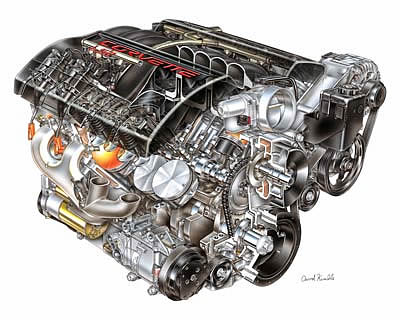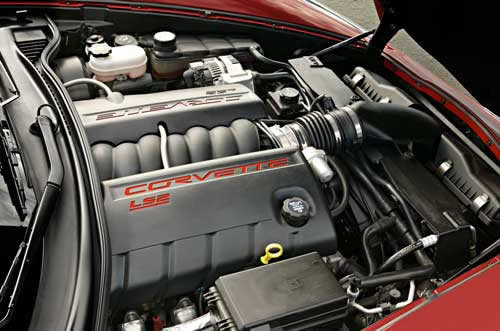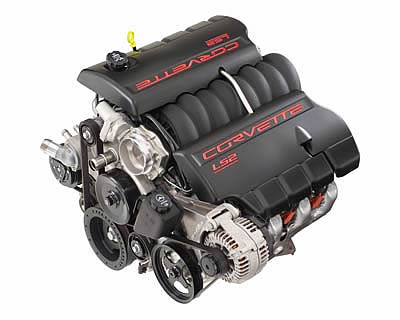C6, Naked and Exposed: Corvette Action Center's First Look at the 2005 Corvette - Page 4 of 6
 |
 |
C6, Naked and Exposed: Corvette Action Center's First Look at the 2005 Corvette - Page 4 of 6
by Hib Halverson
©2004 Corvette Action Center
No use without permission
More Power
Ok. Let's pop the hood and, while were doing that, know that, though C6's hood is not carbon fiber, which some were expecting after GM used it on some '04 Z06es, it is 15% smaller, 35% lighter and 30% stiffer, in spite of being made of the same old stuff. Closing effort decreases by 50% and-oh thank you lord-it latches securely at a single position. No more running around the front of the car to latch the other side of a hood that didn't catch.
Just a little over two years ago, in an article for the Idaho Corvette Page: Ruthless Pursuit of Power: The Sequel, I stated that C6's engine would be six-liters and 400 horsepower. Sure enough, dubbed "LS2", displacing 6.0L (for traditionalists, that's 366 cubic inches) and making 400hp, it's the biggest, most powerful base engine offered in Corvette's 52-year history.
LS2 is a member of General Motors Powertrain (GMPT) Division's new "Generation Four" (Gen IV) Small-Block Engine Family which is a derivation of the Gen III engines used in C5. While Gen IV is not the great departure from Gen III that Gen III was from the old Small-Block V8 used up until 1996, GMPT has certainly made some improvements which are:
- 50 more horsepower.
- 25 lbs/ft more torque for manuals and 40 more for automatics.
- 800 rpm higher power peak. 400 rpm higher torque peak.
- New aluminum block casting with external knock sensor mounts and revised oil galleries.
- Bore size increased to 101.6 mm (4.00 inches).
- Flat-top piston with lower ring tension.
- Full floating wrist pins.
- Compression raised to 10.9:1.
- Camshaft lift increased.
- Camshaft sensor relocated from the front to the rear of the block provides room for new oil galleries.
- Stronger timing chain.
- Redesigned, "wingless" oil pan.
- New cylinder heads derived from the 01-04 LS6.
- New valve springs.
- Larger, 90-mm throttle body.
- Exhaust manifolds 33-percent lighter and capable of four-percent better flow.
- More efficient ignition coils requiring less energy to provide a comparable spark.
- Reduced-mass water pump design with improved sealing capability.
- Iridium-tipped spark plugs.
- Revised and more powerful engine controller which incorporates all electronic throttle control functions.
- Engine redline raised to 6500 rpm.
- No fuel economy loss despite increased power
- Mass of automatic version has been reduced by 15.4 lbs.
- LS2s in Z51s are fitted with an engine oil cooler.
It's interesting GM Powertrain is trying lower piston ring tension because that's part of what got GMPT into trouble with Gen III. High oil consumption by some '97-'01 engines was eventually fixed under warranty with a higher tension oil ring expander and a new second compression ring. It will be interesting to see how low tension rings work-out this time around.
GM seems to be giving-in to the whiners who believe cold piston knock is actually a problem. Turned into a massive "piston slap flap" by Internet conspiracy theorists masquerading as experts, cold piston knock is usually an minor annoyance which goes away a few minutes after start-up. Nevertheless, going to full-floating pins may help address cold piston knock but, more importantly, it will enhance reliability/durability when the Gen IV is released in a high-performance, LS7 version.
The block oil galleries were revised to supply oil pressure for the special valve lifters and other hydraulic devices which make-up the Displacement on Demand (DoD) system. The knock sensors were moved to make room for DoD hardware. At this point, those changes are of no consequence. The Corvette does not use DoD because of a structure resonance problem which makes it obvious the engine is running as a four-cylinder. The six-liter's, 5.3-liter GEN IV cousin (due in '05 in mid-sized SUVs) will use DOD, so, in the interest of efficiency at the foundry; all Gen IV aluminum blocks have the same oiling system.
One of the biggest, late-development challenges in taking the LS1 to production back in the mid-'90s was getting reliable oil pressure at high rpm and maximum lateral acceleration. A result of work done to that end was C5's so-called "batwing" oil pan. During the LS2 development, engineers obtained reliable oiling with a "standard" type oil pan and a quart less oil capacity. GM offered no specifics of this new pan other than saying it comes "...with cast baffling, has reduced mass and provides superior oil control." Time (on the race track) will tell.
The new heads use the same valve sizes and port configurations of the LS6. A six-liter Gen IV gets within 100 rpm of the LS6 without the LS6's hollow stem valves. Almost 11:1 compression is just short of amazing on pump gas, especially the 91-octane (rather than the recommended 93-octane) which is all you can get in some parts of the country, especially out West. No doubt, when running 91 on anything else but a cool day, the engine controls will rely on knock retard (and the toll it takes on performance) to keep the engine out of detonation. Like the LS1 and LS6 before it, we suspect LS2 will take 93.5-to-94-octane to eliminate knock retard under all conditions.
The 2005 Corvette exhaust system is all new. LS2 goes back to two catalytic converters. To hasten cat light-off in the interest of low exhaust emissions, they are mounted close to the exhaust manifolds. Improved cat technology, perhaps similar to that introduced on the Z06 for 2002, enabled GM to get rid of the pup cats used on base engines since 2000 in California and 2001 nationwide. The new cats, also, allowed elimination of the electric air injection system, used on base engines since 1992 and which ran for a short time, right after start-up.
The exhaust behind the cats also changes with sharp-curved tubing replaced with, less-restrictive, more gentle bends. Inline mufflers, which flow more efficiently, replace C5's laterally mounted mufflers. These changes reduced back pressure in the system and contributed to the LS2's increased performance. The new mufflers eliminate certain unwanted noise, particularly between 1500 and 2400 rpm with "tri-flow technology" (the nature of which was not explained) and larger volume.
LS2, with 400hp, in a car that gets 22.6 miles-per-gallon (EPA combined rating), is more efficient that most of its competitors' engines. Some (Ferrari 575, Viper, Porsche Turbo) have more powerful engines, some (Porsche 911, Ferrari Modena) have engines of the same or less power, but none can get the kind of mileage the C6 gets. The closest competitor is the Porsche 911 at 20.6 mpg. The rest are below 20 and the Ferarris get 12.7. 'Course, if you got a Ferarri, you don't care about fuel mileage anyway and probably don't care your engine is not very efficient, either.
Shifting Revisions
Both transmissions have been revised for the sixth-generation car. The Tremec T56 six-speed manual shifts more smoothly and precisely. For shorter-throw shifts, there is a new, shorter, shift lever and synchronizers with 10 percent less travel. A new linkage and new shift-rail bearings inside the trans enhance shift feel and reduce effort. 2005 Corvettes ordered with Z51 and a manual will get those revisions along with a special, "MZ6" gear set consisting of the lower, first-through-fourth gears used in 01-04 Z06es (for quicker acceleration), a taller fifth gear (for higher top speed) and a transmission cooler. This cooler is an oil-to-coolant heat exchanger and the pump is gear driven and inside the trans. The dreaded Computer Aided Gear Selection (CAGS) continues as a fuel-economy enhancement. We have never understood the stress CAGS causes. When a Corvette is driven properly, it's rare that CAGS is enabled.
C6's automatic is the Hydra-matic, 4L65-E, electronically-controlled, four-speed automatic. Originally developed for high-performance light trucks as the "4L60-E HD," this transmission is a beefed-up version of the 4L60-E, used on Corvette from 1993 to 2004. The 4L65-E uses the same gear ratios but has a higher input torque rating of 380 lbs/ft. The key features behind its higher capacity are:
- Input and reaction planetary gearsets with five rather than four pinion gears. Spreading the load over five pinions rather than four increases torque capacity.
- The stator shaft splines, which engage the stator's roller clutch, are heat-treated.
- The turbine shaft, which transfers torque from the converter to the input planetary gearset, is induction hardened.
- Stronger low/reverse roller clutch assembly.
- Seven plates in the 3-4 clutch rather than six.
- Shotpeened output shaft.
- A revised valve body and controller calibration.
GM also makes a big deal about something called "Performance Algorithm Shifting". Information released so far claims, "This technology automatically selects the optimal gear for a given driving condition, making it a willing accomplice for performance driving and hard cornering." Sheesh, more spin. We think this is more advanced transmission software which, using the C6's various sensor inputs, tries to anticipate more about what the driver is doing with the car in a performance driving, ie: if you're off the throttle and generating a lot of lateral acceleration, the trans. might hold a lower gear. We'll have more on this when we do our drive test later this year.
LS2 puts out 400 lbs/ft. torque but the "L65" can tolerate only 380. Though GM did not discuss that issue, we suspect the LS2's PCM applies torque management to the engine when the trans. shifts at WOT and high rpm. Some media rumored C6 would share the Cadillac XLR's 5L50-E five-speed auto. Those who actually understand GM Powertrain's product line know the 5L50 (311 lb/ft. input torque rating) is not strong enough for the LS2's output. Additionally, it's debatable whether a five-speed automatic would offer a valuable performance improvement over a four-speed when used with a engine having the LS2's torque curve.
GM Powertrain announced in 2003 that it was developing six-speed automatic transmissions for rear-drive applications. It is unknown if this project will result in a "6L65-E" but the marketing clamor for a six-speed automatic continues to grow and we figure there's a chance it's in GM's C6 plans for some later date. We also won't deny the gadget freaks' constant lament about the lack of a paddle shifter in the Corvette. Perhaps that will arrive with a "6A" transmission.
C5 rear axle ratios carry-over to C6: 2.73 base automatic, 3.15 performance automatic and 3.42 for all manuals. Though GM did not release anything on this, we'll guess that, because of the 25-40 lb/ft increase in torque, the base C6 rear axle gets the reliability/durability enhancements used in 01-04 Z06 axles. For '05, the limited-slip preload was increased to improve handling and stability when the car is really being pushed hard on corner entries. Axles on C6 Z51s have a gear oil cooler. Like the one in the trans, it's internal and gear driven. It pumps the gear lubricant through an "oil-to-oil" cooler inside the transmission. Rear axle lubricant is cooled by the trans. lube which is, in turn, cooled by the radiator-elegant engineering solution, indeed.
 |
 |


